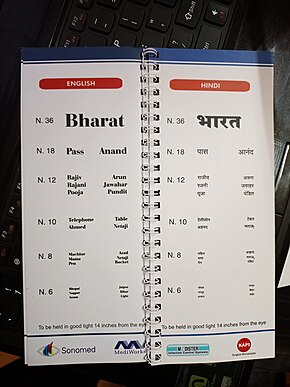Near visual acuity
| Near visual acuity | |
|---|---|
 N notation reading chart in English and Hindi languages |
Near visual acuity or near vision is a measure of how clearly a person can see nearby small objects or letters. Visual acuity in general usually refers clarity of distance vision, and is measured using eye charts like Snellen chart, LogMAR chart etc. Near vision is usually measured and recorded using a printed hand-held card containing different sized paragraphs, words, letters or symbols. Jaeger chart, N notation reading chart and Snellen's near vision test are the commonly used charts for measuring and recording near visual acuity. Near vision testing is usually done after correcting visual acuity at a distance.
Eye conditions like presbyopia, accommodative insufficiency, cycloplegia etc. can affect the near visual acuity. According to the World Health Organization, the near visual acuity less than N6 or M0.8 at 40 cm is classified as near visual impairment.
Physiology of near vision

In human, near vision is obtained by a mechanism called accommodation. With the help of accommodation, a normal young human eye can change focus from distance (infinity) to as near as 6.5 cm from the eye.[2][3] This change in focal power of the eye of approximately 15 diopters (the reciprocal of focal length in meters) occurs as a consequence of a reduction in zonular tension induced by ciliary muscle contraction. This process can occur in as little as 224 ± 30 milliseconds in bright light.[4]
The amplitude of accommodation declines with age. The dependency of accommodation amplitude on age is graphically summarized by Duane's classical curves.[1]
Near vision impairment
The difficulty in reading small prints or blurring at a reading distance is commonly defined as Near vision impairment (NVI). Difficulty with near vision increases with age.[5] Eye conditions like presbyopia, accommodative insufficiency, cycloplegia etc. can affect the near visual acuity. Ocular diseases that cause defective distance vision like cataract and macular degeneration, can also cause reduced near vision.[5]
According to the World Health Organization, the near visual acuity less than N6 or M0.8 at 40 cm is classified as near visual impairment.[6]
Presbyopia
Presbyopia is physiological insufficiency of accommodation associated with the aging of the eye that results in defective near vision.[7] Management of presbyopia includes corrective glasses such as a special pair of reading glasses, contact lenses, bifocals, or progressive lenses.[8]
Insufficiency of accommodation
Insufficiency of accommodation also known as Accommodative insufficiency is another condition that causes blurring of the near vision.[9] Management of accommodative insufficiency needs correcting any underlying refractive errors.[9] Vision therapy may also help improving the condition.[9]
Cycloplegia
Cycloplegia is the paralysis of the ciliary muscle causing paralysis of accommodation and defective near vision.[10] Cycloplegia can be caused intentionally by instilling some medications into the eyes, or it can occur due to some neurological disorders, or trauma to the eye.[11]
Hypermetropia
Hypermetropia, the most common refractive error in childhood, affects the near vision more than distant vision.[12]
Tests for near vision
To measure near vision, a patient is seated in a well illuminated room is asked to read the handheld near vision chart kept at a distance of 25–35 cm away from the eye.[13] The distance used for near vision testing may vary depending on the occupation or basic need of the patient.[14] The smallest test type that the patient can read is the measure of his near acuity. Commonly used tests for near vision are described below.
Jaeger chart
The Jaeger chart is a card on which paragraphs of text are printed, with the text sizes increasing from 0.37 mm to 2.5 mm.[15] This card is to be held by a patient at a fixed distance from the eye dependent on the J size being read. The smallest print that the patient can read determines their near visual acuity.[16]
Roman test types
Roman test types also known as N notation reading charts or Point chart,[17] uses Times New Roman font, and records near visual acuity as N5, N6, N8, N10, etc.[13] N notation is the standard near vision test in the United Kingdom and Australia.[18]
M-scale notation
The M-scale indicate the distance in metres at which the height of a lower case 'x' letter subtends a visual angle of 5 minutes of arc at the nodal point of the eye.[18] The M system is said to have sufficient advantages over other systems for near vision testing to make it a universally accepted standard method.[19] M-scale notation is widely used in North America.[18]
Snellen's near vision test

Snellen's near vision test is a near vision chart introduced by Dutch ophthalmologist Herman Snellen, which uses the same principle of his distance vision Snellen chart.[13] Size of Snellen's near vision chart is approximately 1/17th of the normal Snellen chart.[13]
Sloan Reading Cards
Sloan reading cards which uses continuous text paragraphs with logarithmic progression of optotype sizes, was a reading chart introduced in 1960s.[20] Near acuity was recorded as 1.0 M, 1.5 M, 2.0 M etc.
Bailey-Lovie Word Reading Charts
Bailey-Lovie charts introduced in 1980s, which measures reading acuity and reading speed, uses logarithmic progression of optotype sizes.[20]
MNREAD acuity chart
The MNREAD acuity chart is a text based chart used to measure near visual acuity in people with normal or low vision.[21] It can also be used to measure maximum reading speed, critical print size and the reading accessibility index of a person.[22] Digital and printed types of charts are available.[23]
Standardization of reading charts
The concept of logarithmic progression of optotype sizes for distance vision charts was introduced by John Green, in 1868.[24] However, apart from the reading chart developed by Birkhaeuser in 1911, none of the charts in use at the time were standardized.[20] Aiming to overcome the standardization problem of Jaeger charts, N-notation was introduced in 1950s, but this too was not fully logarithmic.[20] This was followed by the introduction of logarithmic Sloan reading cards in the early 1960s and then the Bailey-Lowey word reading charts in the 1980s.
Standardization criteria established by the International Council of Ophthalmology (ICO) or EN ISO 8596 directive include the reproducibility, comparability, validity, interpretability and reliability of reading tests.[25] Reading charts which uses a logarithmic progression of print sizes, like Sloan Reading Cards, the Bailey-Lovie Word Reading Charts, the MNREAD charts, the RADNER Reading Charts, the Colenbrander Continuous Text Near Vision Cards, the Smith-Kettlewell Reading Test, the Oculus Reading Probe II, the C-Read Charts and the Arabic-BAL Chart etc. are near vision charts that meet standardization criteria published by the ICO.[25]
Conversion
| Roman | Jaeger | Snellen (US) |
Snellen (Metric) |
Decimal | M unit |
|---|---|---|---|---|---|
| N4.5 | J1 | 20/20 | 6/6 | 1.00 | 0.5 |
| N5 | J3 | 20/30 | 6/9 | 0.67 | 0.8 |
| N6 | J5 | 20/40 | 6/12 | 0.50 | 1.0 |
| N8 | J6 | 20/50 | 6/15 | 0.40 | - |
| N10 | J7 | 20/60 | 6/18 | 0.33 | 1.2 |
| N12 | J9 | 20/80 | 6/24 | 0.25 | - |
| N14 | J10 | 20/100 | 6/30 | 0.20 | 1.3 |
References
- ^ a b Duane, Alexander (1922). "Studies in Monocular and Binocular Accommodation with their Clinical Applications". American Journal of Ophthalmology. 5 (11): 865–877. doi:10.1016/s0002-9394(22)90793-7. S2CID 43172462.
- ^ Chen, Ai Hong; O'Leary, Daniel J.; Howell, Edwin R. (2000). "Near visual function in young children". Ophthalmic & Physiological Optics. 20 (3): 185–198. doi:10.1016/S0275-5408(99)00056-3, Fig. 5.
{{cite journal}}: CS1 maint: postscript (link) - ^ That value follows from the maximum accommodative power and can be calculated as 100 cm/15 dpt.
- ^ Lockhart, T. E.; Shi, W. (2010). "Effects of Age on Dynamic Accommodation". Ergonomics. 53 (7): 892–903. doi:10.1080/00140139.2010.489968. PMC 2908311. PMID 20582770.
- ^ a b Varadaraj, Varshini; Lee, Moon Jeong; Tian, Jing; Ramulu, Pradeep Y.; Bandeen-Roche, Karen; Swenor, Bonnielin K. (26 August 2019). "Near vision impairment and Frailty: Evidence of an association". American Journal of Ophthalmology. 208: 234–241. doi:10.1016/j.ajo.2019.08.009. ISSN 0002-9394. PMC 6888870. PMID 31465753.
- ^ "World report on vision". World Health Organization. p. 11. Retrieved 2022-03-03.
- ^ Khurana, AK (September 2008). "Asthenopia, anomalies of accommodation and convergence". Theory and practice of optics and refraction (2nd ed.). Elsevier. pp. 100–107. ISBN 978-81-312-1132-8.
- ^ "Presbyopia - EyeWiki". eyewiki.aao.org.
- ^ a b c Enaholo, Ehimare S.; Musa, Mutali J.; Zeppieri, Marco (2024). "Accommodative Insufficiency". StatPearls. StatPearls Publishing. PMID 36508537.
- ^ Kaur, Kirandeep; Gurnani, Bharat (2024). "Cycloplegic and Noncycloplegic Refraction". StatPearls. StatPearls Publishing. PMID 35593830.
- ^ "Cycloplegia: The Eye Condition That Affects Your Ability to Focus Up Close".
- ^ Majumdar, Soumyadeep; Tripathy, Koushik (2024). "Hyperopia". StatPearls. StatPearls Publishing. PMID 32809551.
- ^ a b c d Khurana (2008). Theory and Practice of Optics and Refraction. Elsevier India. p. 49. ISBN 9788131211328.
- ^ Caltrider, David; Gupta, Abhishek; Tripathy, Koushik (2024). "Evaluation of Visual Acuity". StatPearls. StatPearls Publishing. PMID 33231977.
- ^ Blesi, Michelle; Wise, Barbara; Kelley-Arney, Cathy (2011). Medical Assisting Administrative and Clinical Competencies. Cengage Learning. pp. 888–890. ISBN 978-1133706960.
- ^ G.K. & Pal; Pal; Pravati (1 February 2006). Textbook Of Practical Physiology (2nd ed.). Orient Blackswan. pp. 328–. ISBN 978-81-250-2904-5.
- ^ Houf, James W. (October 2009). "Understanding Near Vision Eye Tests". The American Society for Nondestructive Testing. 8 (4).
- ^ a b c ELLIOTT, DAVID B (2007). Clinical Procedures in Primary Eye Care (3 ed.). Elsevier. pp. 38–41. ISBN 9780750688963.
- ^ Jose, R. T.; Atcherson, R. M. (September 1977). "Type-size variability for near-point acuity tests". American Journal of Optometry and Physiological Optics. 54 (9): 634–638. ISSN 0093-7002. PMID 596414.
- ^ a b c d Radner, W. (2017). "Reading charts in ophthalmology". Graefe's Archive for Clinical and Experimental Ophthalmology. 255 (8): 1465–1482. doi:10.1007/s00417-017-3659-0. ISSN 0721-832X. PMC 5541099. PMID 28411305.
- ^ Altinbay, Deniz; Adibelli, Fatih Mehmet; Taskin, Ibrahim; Tekin, Adil (2016). "The Evaluation of Reading Performance with Minnesota Low Vision Reading Charts in Patients with Age-related Macular Degeneration". Middle East African Journal of Ophthalmology. 23 (4): 302–306. doi:10.4103/0974-9233.194078. ISSN 0974-9233. PMC 5141623. PMID 27994393.
- ^ Calabrèse, Aurélie; Cheong, Allen M. Y.; Cheung, Sing-Hang; He, Yingchen; Kwon, MiYoung; Mansfield, J. Stephen; Subramanian, Ahalya; Yu, Deyue; Legge, Gordon E. (1 July 2016). "Baseline MNREAD Measures for Normally Sighted Subjects From Childhood to Old Age". Investigative Ophthalmology & Visual Science. 57 (8): 3836–3843. doi:10.1167/iovs.16-19580. ISSN 1552-5783. PMC 4961000. PMID 27442222.
- ^ Calabrèse, Aurélie; To, Long; He, Yingchen; Berkholtz, Elizabeth; Rafian, Paymon; Legge, Gordon E. (19 January 2018). "Comparing performance on the MNREAD iPad application with the MNREAD acuity chart". Journal of Vision. 18 (1): 8. doi:10.1167/18.1.8. ISSN 1534-7362. PMC 5774869. PMID 29351351.
- ^ Green, John (1868). "On a New Series of Test-Letters for determining the Acuteness of Vision". Transactions of the American Ophthalmological Society. 1 (4–5): 68–71. ISSN 0065-9533. PMC 1361516. PMID 16691740.
- ^ a b Ntonti, Panagiota; Mitsi, Christina; Chatzimichael, Eleftherios; Panagiotopoulou, Eirini-Kanella; Bakirtzis, Minas; Konstantinidis, Aristeidis; Labiris, Georgios (18 January 2023). "A systematic review of reading tests". International Journal of Ophthalmology. 16 (1): 121–127. doi:10.18240/ijo.2023.01.18. ISSN 2222-3959. PMC 9815988. PMID 36659955.
- ^ "Near visual acuity conversion chart" (PDF). UK Civil Aviation Authority.
- ^ "Print Comparison of Font Sizes". Teaching Students with Visual Impairments.
